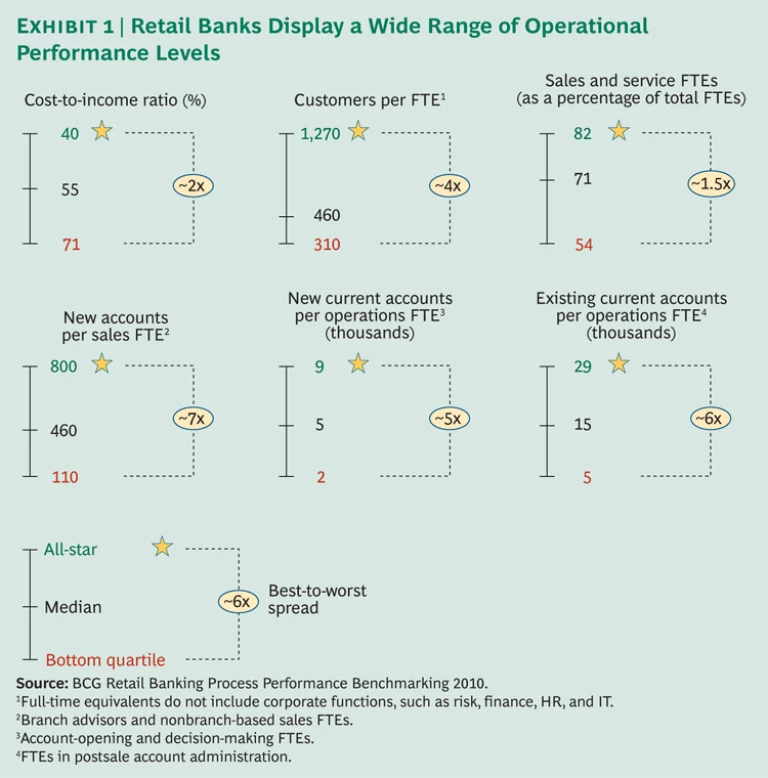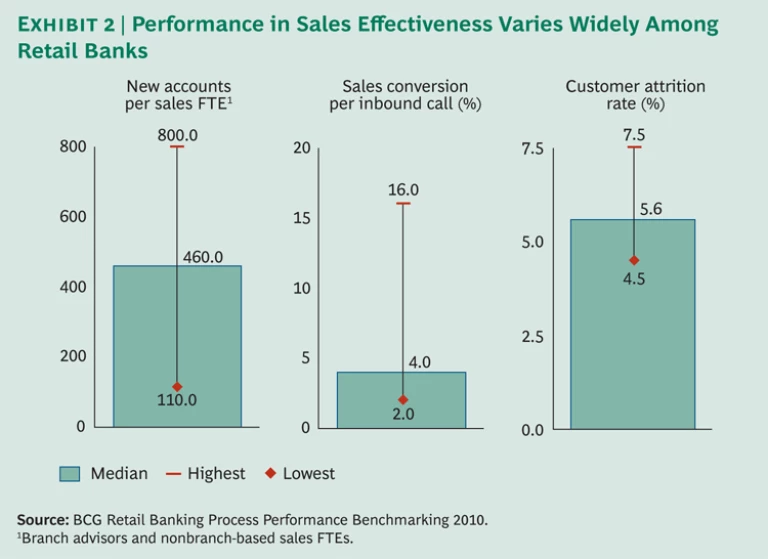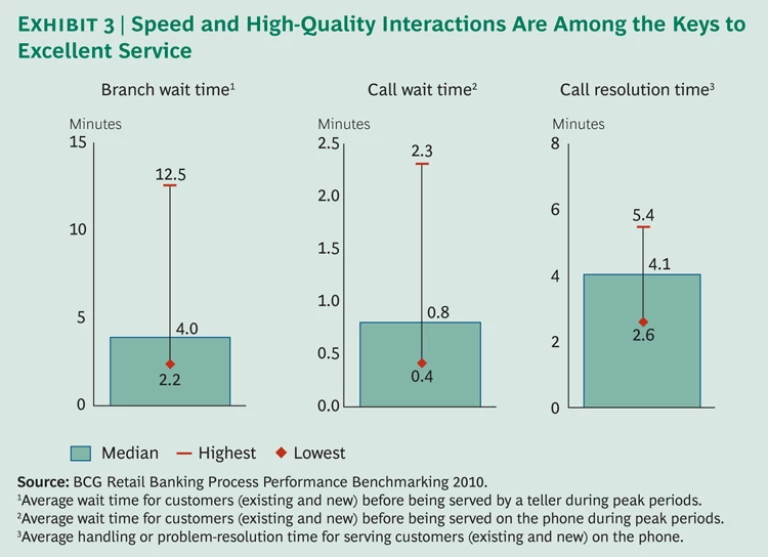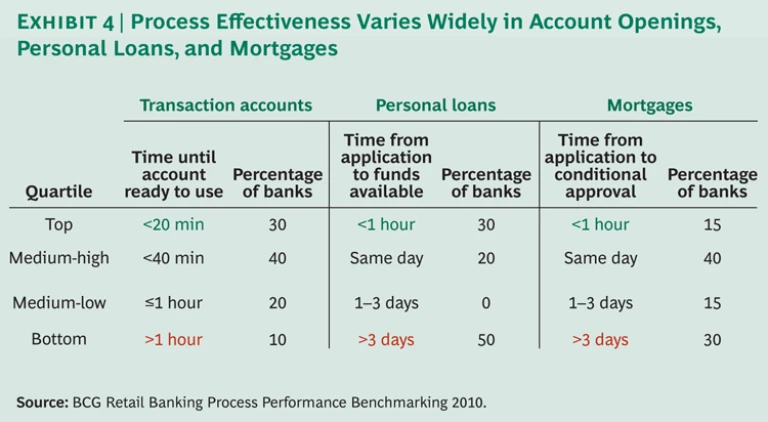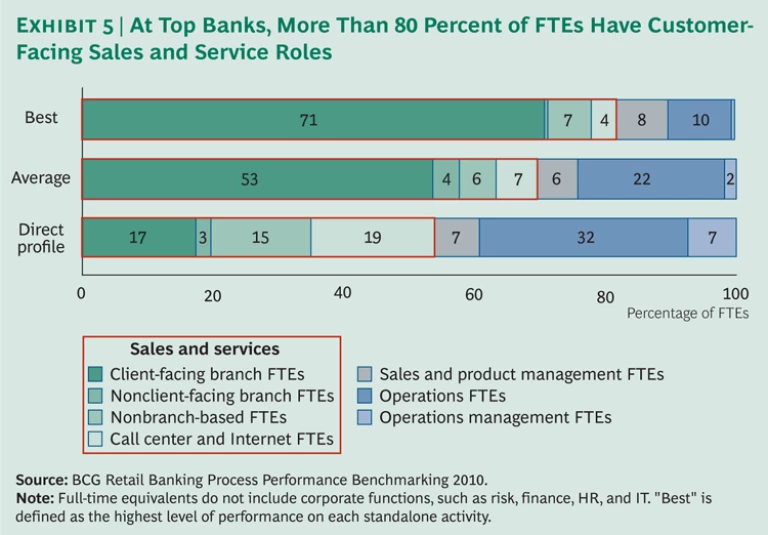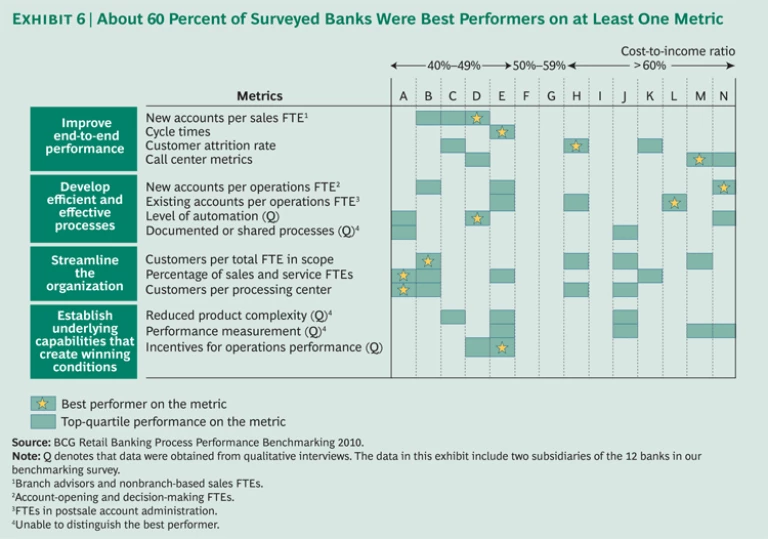Achieving operational excellence is becoming an increasingly pressing item on the agendas of retail-banking CEOs worldwide. Yet while banks generally acknowledge that their processes and productivity could be vastly improved, relatively few have a firm grip on the steps they must take to raise their operations to a level of true excellence.
Read more on this topic
Operational Excellence in Retail Banking: The Series
In order to explore operational performance in depth, The Boston Consulting Group recently conducted a benchmarking survey of 12 of the top 30 retail banks across North America, Europe, and Asia-Pacific—a group that we sometimes refer to as the “premier league” of retail banks. The 12 institutions that we surveyed account for roughly 430 million customers, 51,000 branches, and more than $13.5 trillion in assets. Unlike typical operational benchmarking surveys, which focus solely on back-office processes and metrics, our effort encompassed both operational and client-facing activities, taking a holistic end-to-end perspective on banks’ processes and productivity drivers.
Every bank is, of course, unique—a product of its own history and the nature of its principal markets. But a number of important insights can be drawn from the ways in which these institutions approach processes and productivity, and how these approaches influence their overall performance, their strategies, and the experience of their customers.
Our benchmarking identified top performers along a number of key metrics. It also revealed a wide range of operational performance among retail banks. (See Exhibit 1.) For example, cost-to-income ratios ranged from 40 percent to more than 70 percent, and customers per full-time equivalent (FTE) ranged from 310 all the way up to 1,270.
Such variation indicates that most banks—even those in the premier league—can make significant improvements in operational performance. Moreover, our benchmarking and client work have enabled us to identify four key levers that the best premier-league banks are applying in their quest to break away from the pack and become all-stars—or true process and productivity leaders. These levers are improving end-to-end performance, developing efficient and effective processes, streamlining the organization, and establishing underlying capabilities that create winning conditions.
Below, we examine the profile of a true operational all-star—in particular, how such a bank applies the four key levers. We then examine two specific banks that have used a highly focused set of sublevers to push the boundaries of excellence, allowing them to create and export strategic differentiation.
Four Levers Used by Operational All-Stars
Although our benchmarking indicates that no bank has yet achieved true all-star status, an increasing number of premier-league banks are striving for this goal. Some banks are making considerable progress, while others are finding the journey more difficult. Broadly speaking, a true all-star bank makes the most of all four key levers.
Improve End-To-End Performance
All-star banks ensure that their operations are in sync with their frontline. They organize to achieve high levels of customer retention—annual attrition rates below 5 percent—and cross-selling. They offer the “right” add-ons up front, such as direct deposit, easy sign-up for online banking, and direct debit. They capture all relevant customer information at the beginning of the relationship and use it wisely to bring customers fully on board and keep abreast of their evolving banking needs—identifying early on the customers with higher current and long-term value and tailoring interactions and offers accordingly. Such banks also take a comprehensive end-to-end approach to both sales and service effectiveness.
Sales Effectiveness. All-star banks achieve high end-to-end sales effectiveness, supported by four principal elements:
- Point-of-Sale Optimization. Frontline staff are centered on customer interaction, not on low-value administrative tasks, and they use a scripted and systematic approach to sales—one that gives them incentives to emphasize products that generate “stickiness.”
- A Holistic Approach. Processes are coordinated using a comprehensive, front-to-back approach that monitors and differentiates service levels both internally and externally for increased productivity.
- Multichannel Integration. Emphasis is placed on enabling customers to interact with the bank seamlessly and simply through many channels; sales and service leads are triaged and prioritized on the basis of customer value and preferences.
- Customer-Centric Systems and Processes. Unified sales and servicing platforms, as well as customer relationship management (CRM) tools, are implemented to deliver relevant information succinctly with minimal complexity.
In our survey, we noticed particularly wide dispersion in new accounts per sales FTE and in sales conversion per inbound call—as well as in customer attrition rate. (See Exhibit 2.) We also observed that top performers deploy fast and comprehensive sales processes—such as opening current accounts in less than 20 minutes and making decisions on loans and mortgages in less than one hour. Such banks address customer needs with crisp, effective interactions—which result, if at all possible, in the customer leaving with a functioning product. Obviously, it is important that improvements in speed not be achieved at the expense of overall interaction quality.
Service Effectiveness. All-star banks design and deliver the highest possible level of service, achieving a high proportion of “first time right” client interactions within and across channels. In our survey, the average branch-wait time at the best banks is just over two minutes, while the average call-wait time is under half a minute and the average call-resolution time is well below three minutes. Expedient, high-quality interactions are the differentiator for top performers. (See Exhibit 3.) All-star banks also assess targets and performance levels holistically. For example, a relatively high call-resolution time could result from a large volume of calls that involve complex problems—with simpler calls effectively handled by interactive voice-response systems and better filtering.
To increase productivity, all-star banks differentiate service by client segment (where appropriate) on the basis of explicit, codified service-level agreements. Such banks serve high-value customers with no-hassle resolution of difficult problems, while also providing accurate, “no frills” service in simple interactions with all segments. Segment profitability is always a factor in determining service level, and lower-value segments generally receive cost-effective service commensurate with parallel offerings in the market.
Develop Efficient and Effective Processes
All-star banks push the boundaries of excellence in both process automation and process industrialization.
Process Automation. Front-to-back automation clearly improves overall productivity and the customer experience. All-star banks enable efficient electronic data capture and automated decision-making at the point of sale. They achieve straight-through processing (STP) for the vast majority of new-account openings and new unsecured-credit products. Where STP is not applicable, processes are workflow-enabled with skills-based routing, prepopulation of required documentation, and intelligent validation. We observed significant room for improvement among our survey participants on this dimension, as many banks remain hindered by a large number of manual processes in sales, fulfillment, and servicing.
Process Industrialization. All-star banks industrialize their operations processes along the following lines.
- Process Simplification. Processes are standardized as much as possible in order to maximize throughput—for example, the number of new accounts or loan decisions made per operations FTE—and key processing jobs are segregated into simple and complex tasks.
- Process Quality. Processes and data flows are designed for quality assurance to avoid repetitive quality-control checks; performance is measured holistically, taking all circumstances and processing steps into account.
- Process Sharing Across Products and Channels. Common activities are shared across products and channels, typically starting within product families; extra care is taken to avoid introducing excess complexity.
- Channel- and Location-Agnostic Processing. Processing interactions within product classes are handled in the same way, with consistent interfaces across channels and processing locations.
Among our benchmarking participants, we observed wide dispersion in process effectiveness for account openings, personal loans, and mortgages. (See Exhibit 4.)
Most banks in our survey are working to improve process efficiency and effectiveness. However, few have been able to improve consistently across product portfolios and product life cycles. For example, some institutions have achieved strong performance in processing transaction accounts but lag on mortgages. Others have come a long way when it comes to new-account sales but still struggle in postsale account administration. In addition, many banks could improve overall process industrialization. For instance, only half of our survey participants systematically separate simple and complex tasks, and few share processes among different products or beyond product families.
Streamline The Organization
All-star banks invest in achieving leaner overhead, reducing organizational complexity, and maximizing the percentage of FTEs in customer-facing sales and service roles. At the best-performing banks in our survey, more than 80 percent of FTEs had such roles. (See Exhibit 5.) Of course, any streamlining program must also involve initiatives to centralize processing activities and to outsource selected activities when there are clear benefits to doing so.
Centralization. At all-star banks, processing activities are carried out in a small number of processing centers that serve a designated geographic area, not in branches. Each of these centers typically employs several hundred operations FTEs, enabling scale benefits to be achieved without generating too much complexity. The vast majority of our survey participants are continuing to consolidate their processing centers, with roughly 75 percent aiming to reduce their number of centers in the near future.
Outsourcing and Near- or Offshoring. When it comes to outsourcing and offshoring, there are always successes and failures. Typical reasons for failure include a lack of strategic intent, an inability to optimize processes internally, and unclear assessments of second- and third-order impacts. All-star banks effectively outsource activities that are subscale, repetitive, and nondifferentiating when the economic benefits are both evident and sustainable. Nearly every bank in our survey has selectively outsourced portions of its operations, especially in processing and postsale administration. Outsourcing remains limited, however, with (on average) less than 10 percent of operations FTEs outsourced. All-star banks also practice insourcing for key differentiating activities and in areas where greater scale provides a competitive advantage.
As for strategic near- and offshoring, the obvious purpose is to take advantage of low-cost locations. But banks must carefully assess the tradeoff between the benefits of labor-cost arbitrage and the costs of coordination. As of today, near- and offshoring are limited. Less than 30 percent of our survey participants have near- or offshored more than 20 percent of their processing activities, and few banks plan to take further steps in this area in the near term.
Establish Underlying Capabilities That Create Winning Conditions
All-star banks develop underlying capabilities that create winning conditions inside their organizations—conditions that enable operational excellence. Two critical capabilities are to continuously reduce business complexity and to establish rigorous people-performance management across sales and operations.
Reduced Business Complexity. All-star banks reduce fragmented demands on resources and systems, shortening time to market and facilitating sales force training. Their core objective is to provide a simplified offering that features a high degree of harmonization and integration across channels, business units, and locations. They also seek to offer a streamlined product portfolio—one that is regularly reviewed and trimmed.
We have observed that few banks place enough emphasis on reducing complexity in their product portfolios as they try to manage the tradeoff between developing a highly sophisticated offering and avoiding excess product proliferation. In addition, few banks in our survey have forged a new-product-development program that fully encompasses an end-to-end view of sales and operations processes. Furthermore, all the banks in our survey acknowledged the need for better harmonization and integration across the organization.
Rigorous People-Performance Management Across Sales and Operations. All-star banks achieve a high-productivity culture by setting clear expectations, adopting transparent and continuous performance-monitoring systems, and putting in place highly motivating incentive schemes that are easy to understand and based on aggressive but realistic targets. Performance measurement is complemented by robust training and coaching tailored to specific resource needs, as well as by an effective talent-management process that includes “elite” career tracks and rotation programs for employees. We have observed that few banks deploy a systematic performance-management scheme that is based on rigorous measurement and incentives across operations. One reason for this may be a lack of standardized, easy-to-track data.
Indeed, just one-third of the banks in our survey measured end-to-end operations performance on a regular basis, and only 10 percent had significant incentives linked to end-to-end performance in place. Only a couple of banks provided incentives to employees below the management level.
Examples of key performance indicators include customer satisfaction and retention, task completion time and level of completeness, and cost-to-income ratio.
Exporting Strategic Differentiation
A very small number of retail banks in our survey have not only made progress at becoming leaders in process and productivity but have also chosen to concentrate on a highly focused subset of the above levers—using IT, operations, and other elements to create strategic differentiation. They have come up with a winning formula, typically developed in their home market, and applied it to their cross-border activities—reinforcing their competitive advantage and creating global scale. Examples include a bank that we refer to as the “integrated multichannel sales champion” and one we call the “CIR champion.”
The Integrated Multichannel Sales
This institution opted to differentiate itself through superior sales productivity and strong integration across channels—even though it is still catching up in terms of overall process and productivity excellence. The bank has achieved a high level of sales channel integration, including common IT and customer-information databases, and has enabled a shared-contacts infrastructure. The bank places heavy emphasis on multichannel cohesion and navigation.
Furthermore, this bank optimizes the division of sales-oriented value-chain steps across channels. For example, branches focus on sales of sophisticated products while call centers handle sales of simple products and arrange client appointments with branch advisors via shared calendars. The online channel provides product information and, increasingly, sales and servicing of core banking needs. This bank has a strong multichannel CRM infrastructure that provides comprehensive and consistent client information for efficient contact across all channels.
The CIR Champion
This bank has concentrated on cost-to-income ratio (CIR), driven by IT and operations. It has become a leader in organizational streamlining and improving process efficiency, achieving a CIR of less than 45 percent. The bank focuses on centralized processing, with all new-account openings processed at the Europewide (rather than the country) level. It concentrates its workforce in a limited number of hubs, and its single, core IT platform supports standardized and industrialized processes across markets.
In addition, the CIR champion’s organizational structure supports this strategic differentiator. Management of IT and operations is integrated under a fully empowered CIO. Global shared services across IT and operations capture synergies and share knowledge. The bank’s globally integrated model is rigorously replicated for every acquisition.
It is worth noting that this bank makes a certain number of tradeoffs in implementing its centralized, industrialized model. Its laser-like focus on CIR can create wrinkles in the overall customer experience, such as reduced online functionality after an acquisition or a narrower product range following standardization of the portfolio. Also, a centralized, global model combined with tight cost controls can delay important strategic investments when multiple business lines need to act in unison.
The banking industry’s recent focus on managing out of the crisis proves that cost reduction alone is not enough. Succeeding in the new environment clearly requires excellence in process and productivity. Many banks have made some of the levers discussed above a high priority, pushing them to the top of their management agendas. Our benchmarking results reveal that roughly 60 percent of the banks we surveyed are best performers on at least one of the principal metrics, and all but three demonstrate top-quartile performance in at least one metric. (See Exhibit 6.) None, however, has achieved what we would call full-fledged all-star status, with stellar performances across all metrics. This means that further efforts lie ahead for all banks.
Success in improving processes and productivity—and achieving all-star status in at least some areas—will require a sharpening of focus and continued investment. Banks need to develop a clear understanding of which levers are most critical for their particular strategies and business objectives—an initiative that should include a comprehensive cost-benefit analysis by lever.
Each bank should then convert this understanding into a clear, multiyear transformation plan focused on a selected set of priorities. Banks that commit to undertaking and completing this journey will not only reap vast benefits but will also equip themselves to sustain these benefits in the future.
